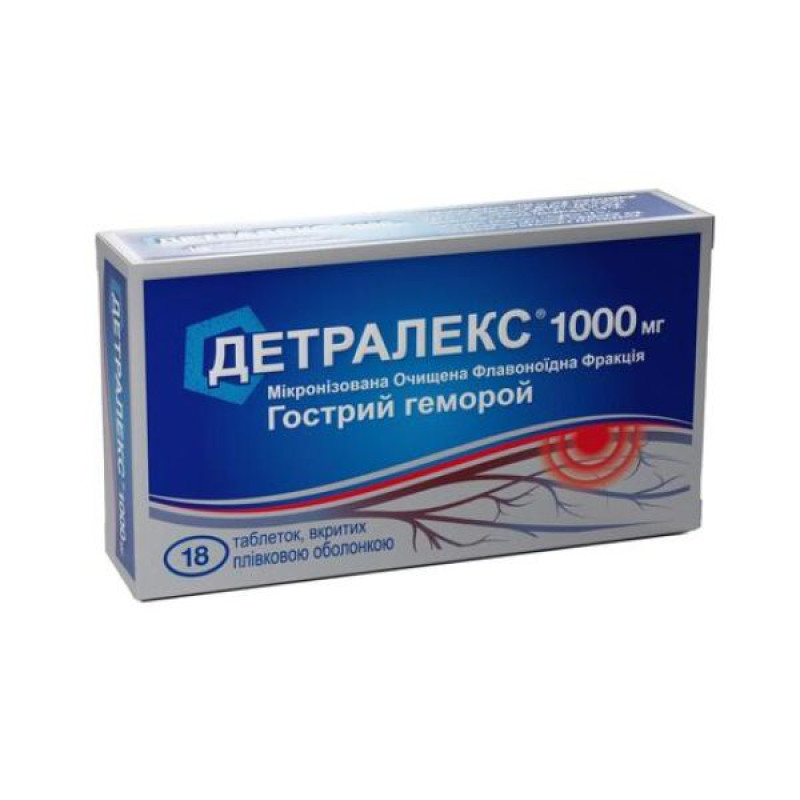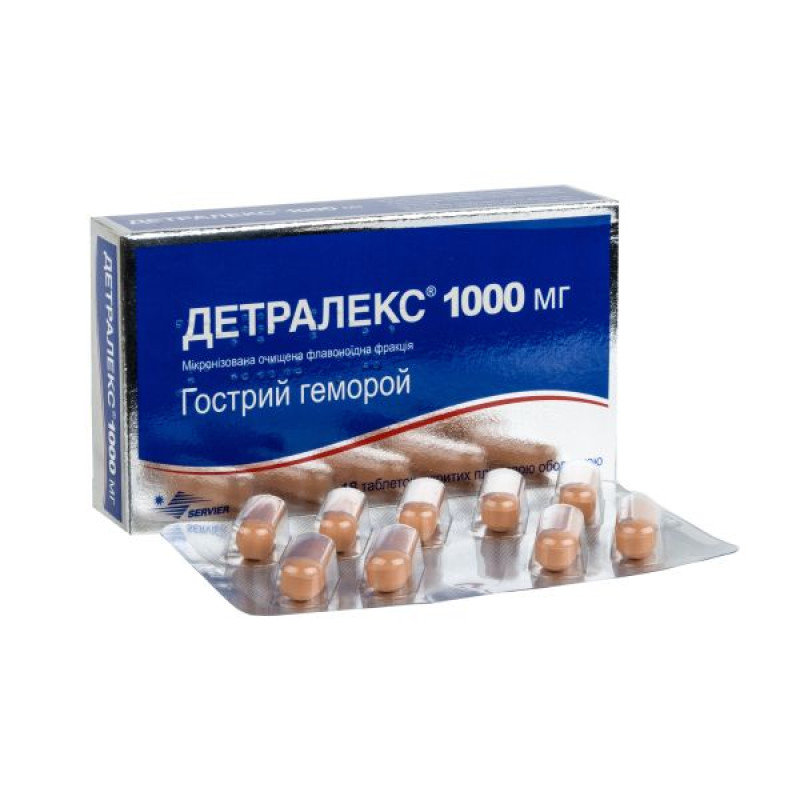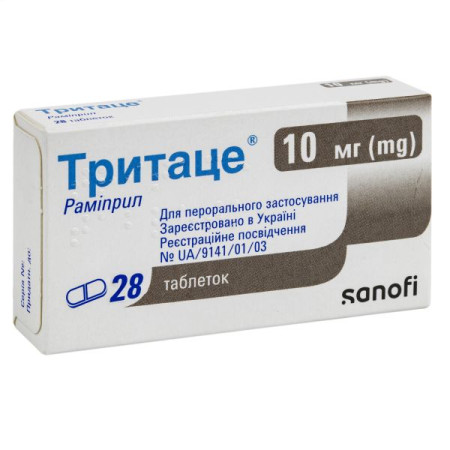Detralex 1000 mg film-coated tablets No. 18

Instructions Detralex 1000 mg film-coated tablets No. 18
Composition
active ingredient: micronized purified flavonoid fraction (diosmin + flavonoids in the form of hesperidin);
1 tablet contains 1000 mg of micronized purified flavonoid fraction, which contains 900 mg of diosmin (90%) and 100 mg of flavonoids in the form of hesperidin (10%);
excipients: microcrystalline cellulose, gelatin, magnesium stearate, sodium starch glycolate (type A), talc, purified water;
film coating: glycerol, hypromellose, macrogol 6000, magnesium stearate, red iron oxide (E 172), sodium lauryl sulfate, titanium dioxide (E 171), yellow iron oxide (E 172).
Dosage form
Film-coated tablets.
Main physicochemical properties: oblong tablet, coated with an orange-pink film coating, with a notch on both sides.
Pharmacotherapeutic group
Angioprotectors. Capillary stabilizing agents. Bioflavonoids. Diosmin, combinations. ATX code C05C A53.
Pharmacological properties
Pharmacodynamics
Pharmacology
Detralex 1000 mg has a venotonic and angioprotective effect, reduces venous distensibility and venostasis, improves microcirculation, reduces capillary permeability and increases their resistance, and also improves lymphatic drainage, increasing lymphatic outflow.
Preclinical pharmacology
An experimental study on animals using the ischemia/reperfusion model showed that the use of a micronized purified flavonoid fraction has a more pronounced effectiveness in reducing vascular wall permeability and blood plasma leakage compared to simple diosmin. This result is due to the presence of a protective effect on microcirculation of flavonoids, such as hesperidin, diosmetin, linarin and isoroifolin, which are part of the fraction in the form of hesperidin. The reduction in vascular wall permeability and blood plasma leakage observed with the use of a micronized purified flavonoid fraction is more significant than that observed with the use of simple diosmin and each component of the flavonoid fraction separately.
Clinical pharmacology
The above pharmacological properties have been confirmed in double-blind, placebo-controlled studies using methods that can determine the effect of the drug on venous hemodynamics.
Dose-effect relationship
A statistically significant dose-dependent effect of the drug was established according to the following venous plethysmographic parameters: venous volume, venous distensibility and venous outflow time. The optimal dose-effect ratio was achieved at 1000 mg per day.
Venotonic activity
Detralex 1000 mg increases venous tone: a decrease in venous outflow time was demonstrated using venous occlusion plethysmography.
Microcirculatory activity
In double-blind, placebo-controlled studies, a statistically significant difference between the drug and placebo was demonstrated. In patients with symptoms of capillary fragility, treatment increased their resistance, which was determined by angiostereometry.
The drug also reduces the interaction of leukocytes and endothelium, leukocyte adhesion in postcapillary venules. This reduces the damaging effect of inflammatory mediators on the walls of veins and the leaflets of vein valves.
In clinical practice
Double-blind placebo-controlled studies have shown the therapeutic activity of the drug in phlebology in the treatment of functional and organic chronic venous insufficiency of the lower extremities, as well as in proctology in the treatment of hemorrhoids.
Pharmacokinetics
The active substance is excreted mainly in the feces. An average of 14% of the dose is excreted in the urine.
The half-life is 11 hours.
The drug is actively metabolized, as confirmed by the presence of various phenolic acids in the urine.
Indication
Symptomatic treatment of venolymphatic insufficiency (heaviness in the legs, pain, night cramps, edema, trophic disorders, including varicose ulcers).
Symptomatic treatment of hemorrhoids.
Contraindication
Hypersensitivity to the active substance or any excipient.
Interaction with other medicinal products and other types of interactions
No interaction studies have been conducted. No clinically significant drug interactions have been reported during post-marketing use of the drug to date.
Application features
The use of this medicinal product for acute hemorrhoids does not replace specific therapy and does not interfere with the treatment of other proctological diseases. If the symptoms do not disappear quickly during a short course of treatment, a proctological examination should be performed and the therapy reviewed.
In cases of venous circulation disorders, it is more effective to combine therapy with adherence to the following lifestyle recommendations:
avoid too much sun exposure, prolonged standing, excess body weight; walk and in some cases wear special stockings to improve blood circulation.
Excipients.
Detralex 1000 mg contains less than 1 mmol sodium (23 mg) per tablet, i.e. it is almost sodium-free.
Ability to influence reaction speed when driving vehicles or other mechanisms
Studies of the effect of the flavonoid fraction on the ability to drive or operate other mechanisms have not been conducted. However, in accordance with the general safety profile of the flavonoid fraction, Detralex 1000 mg has no or negligible effect on this ability. In case of detection of side effects of the drug (see section "Adverse reactions"), caution should be exercised.
Use during pregnancy or breastfeeding
Pregnancy
There are no or limited data from the use of micronized purified flavonoid fraction in pregnant women.
Animal studies have not demonstrated a teratogenic effect.
As a precautionary measure, it is advisable to avoid using the drug during pregnancy.
Breast-feeding
It is not known whether the active substance or its metabolites pass into breast milk.
A risk to newborns/infants cannot be excluded.
A decision on whether to discontinue breast-feeding or to discontinue/abstain from therapy with this medicinal product should be made taking into account the benefit of breast-feeding for the child and the benefit of therapy for the mother.
Fertility
Reproductive toxicity studies in animals showed no effect on fertility.
Method of administration and doses
For oral use.
The score on the tablet is intended to divide the tablet solely for ease of swallowing, but not for dividing into equal doses.
It is intended for adults.
The duration of therapy is determined by the doctor depending on the indication for use and the course of the disease.
Venolymphatic insufficiency
The recommended dose of the drug is 1 tablet per day in the morning with a meal.
Hemorrhoid disease
Treatment of acute hemorrhoid episodes: 3 tablets per day for 4 days, then 2 tablets per day for the next 3 days. Take with meals. Divide the daily dose into 2-3 doses. Maintenance therapy - 1 tablet per day.
Children
There are no data on the use of Detralex 1000 mg in children.
Overdose
Symptoms
There is limited data on overdose with this medicinal product. The most common adverse reactions reported in overdose were gastrointestinal reactions (such as diarrhoea, nausea, abdominal pain) and skin reactions (such as pruritus, rash).
Treatment
Treatment of overdose should include therapy of clinical symptoms.
Adverse reactions
During clinical studies, moderate side effects were observed with the use of micronized purified flavonoid fraction, mainly from the gastrointestinal tract (diarrhea, dyspepsia, nausea, vomiting).
The following adverse reactions have been reported and are classified according to frequency: very common (≥ 1/10); common (≥ 1/100, < 1/10); uncommon (≥ 1/1000, < 1/100); rare (≥ 1/10000, < 1/1000); very rare (< 1/10000); frequency unknown (cannot be estimated from the available information).
Nervous system: rarely: dizziness, headache, malaise.
Gastrointestinal disorders: common: diarrhea, dyspepsia, nausea, vomiting; uncommon: colitis; frequency unknown*: abdominal pain.
Skin and subcutaneous tissue disorders: rarely: itching, rash, urticaria; frequency unknown*: isolated swelling of the face, lips, eyelids, in exceptional cases - Quincke's edema.
* Post-marketing surveillance.
Reporting of suspected adverse reactions. Reporting of suspected adverse reactions during the post-marketing period of a medicinal product is important. This allows for continuous monitoring of the benefit/risk balance of the medicinal product. Healthcare professionals are required to report any suspected adverse reactions through the national reporting system.
Expiration date
4 years.
Storage conditions
Does not require any special storage conditions. Keep out of the reach of children.
Packaging
9 tablets in a blister made of aluminum foil and PVC film, 2 blisters in a cardboard box.
Vacation category
Without a prescription.
Producer
Servier Industries Laboratories.
Location of the manufacturer and its business address
905 rue de Saran, 45520 Guidy, France.
There are no reviews for this product.
There are no reviews for this product, be the first to leave your review.
No questions about this product, be the first and ask your question.









